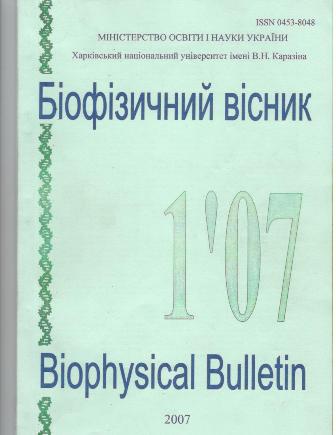Anisotropic organic media as model bioequivalent systems. I. Liquid crystals containing dispersed multiwall nanotubes under aspects of anisotropic intermolecular interactions
Abstract
Dispersions of carbon nanotubes (NT) in liquid crystals have been considered as a model system for studies of anisotropic intermolecular interactions in condensed organic media. Electric conductivity data were obtained for nematic liquid crystals (LC) with small (0.01-0.15 wt %) concentrations of multiwall NT dispersed therein. The electric conductivity increased noticeably with NT concentration in the LC matrix, suggesting a percolation-like behaviour at NT content in the LC matrix below ~0.01 wt %. A marked difference in the measured electric conductivity values for the LC matrices of different polarity (e.g., cyanobiphenyl and azoxy) was observed. Assuming that supramolecular arrangement of NT dispersed in the LC matrix can be treated in a manner similar to the conventional non-mesogenic dopants, the observed behaviour is explained using our recent theoretical description of intermolecular interactions in anisotropic organic media formed by particles of essentially different size and anisometry.
Downloads
References
Lovat V, Pantarotto D, Lagostena L, Cacciari B, Grandolfo M, Righi M, et al. Nano Letters. 2005;5:1107-10.
Lisetski LN, Malikov VYa, Sidletski OTs, Stadnik PE. Mol.Cryst. Liq.Cryst. 1998;324:243-9.
Lisetski LN, Vashchenko OV, Tolmachev AV. Vodolazhskiy KB. Eur.Biophys.J. 2002;31:554-8.
Patrick DL, Wilkinson FS, Fergurgur TL. Proc.SPIE 2005;5936:59360A (8p.)
Russell JM, Oh S, LaRue I, Samulski ET. Thin Solid Films. 2006;509:53-7.
Song W, Kintoch IA, Windle AH. Science. 2003;302:1363.
Lynch MD, Patrick DL. Nano Letters. 2002;2:1197-201.
Song W, Windle AH. Macromolecules. 2005;38:6181-8.
Duran H, Gazdecki B, Yamashita A, Kyu T. Liq.Cryst. 2005;32:815-21.
Dierking I, Scalia G, Morales P, LeClere D. Advanced Materials. 2004;16:865-9.
Lisetski LN, Lebovka NI, Sidletsky OTs, Panikarskaya VD, Kasian NA, Kositsyn SS, et al. Functional Materials. 2007;14(2).
Melezhyk AV, Sementsov YuI, Yanchenko VV. Russian J.Appl.Chem. 2005;78:924-30.
Bezrodna T, Chashechnikova I, Dolgow L, Puchkovska G, Shaydyuk Ye, Lebovka N, et al. Liq.Cryst. 2005;32:1005-12.
Chashechnikova I, Dolgov L, Gavrilko T, Puchkovska G, Shaydyuk Ye, Lebovka N, et al. J.Mol.Struct. 2005;744-747:563-71.
Zhang Q, Rastogi S, Chen D, Lippits D, Lemstra PJ. Carbon. 2006;44:778-85.
Shtifanyuk PP, Dyomin AV, Fedoryako AP, Lisetski LN, Yakovenko SE. Functional Materials. 2004;11:661-70.
Shtifanyuk PP, Dyomin AV, Fedoryako AP, Lisetski LN, Yakovenko SE. Biophysical Bulletin. 2005;1(15):49-52.
Authors who publish with this journal agree to the following terms:
- Authors retain copyright and grant the journal right of first publication with the work simultaneously licensed under a Creative Commons Attribution License that allows others to share the work with an acknowledgement of the work's authorship and initial publication in this journal.
- Authors are able to enter into separate, additional contractual arrangements for the non-exclusive distribution of the journal's published version of the work (e.g., post it to an institutional repository or publish it in a book), with an acknowledgement of its initial publication in this journal.
- Authors are permitted and encouraged to post their work online (e.g., in institutional repositories or on their website) prior to and during the submission process, as it can lead to productive exchanges, as well as earlier and greater citation of published work (See The Effect of Open Access).





